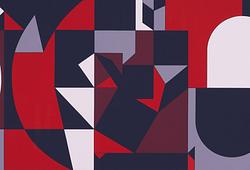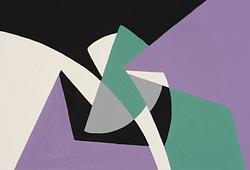Isaac Grünewald
"Par under Edens Äppelträd" from Paradissviten.
Signed Grünewald and dated -43. Tempera on canvas mounted to panel 130 x 297 cm.
Täydennyslista
Canvas mounted to panel.
Alkuperä - Provenienssi
Master Builder Clas Groschinsky (1885–1966), Stockholm.
Professor Paul Frenckner, Stockholm.
Private Collection.
Muut tiedot
Couple under the Apple Tree in Eden from the Paradise Suite was originally part of a suite of seven paintings created for the drawing room at Stångberga Farm north of Stockholm. In the 1940s, master builder Clas Groschinsky (1885–1966) had a new red brick residence built and hired his friend, artist Isaac Grünewald, to decorate the rooms. The commission included both the murals in the almost square drawing room and a colour scheme that would give each room in the house its own character and tone.
In the monumental main motif from the Paradise Suite, which is now being presented in this auction, Grünewald uses a blue base colour scheme of cobalt and ultramarine. Adam and Eve are placed under a swaying apple tree surrounded by waterfalls, four-legged animals, rock formations and flower arrangements. The entire scene is bathed in a blue shimmer, where the pink tones of Eve's skin contrast with the green foliage, while the pink colour recurs in the bark of the tree and in the play of light over the rocks. Inspired by Henri Matisse and French colour expressionism, Grünewald lets colour and imagination run free – an expression of his desire to introduce a modern, colour-intensive style into Swedish art, both in private and public spaces.
During the interwar period, Grünewald had participated in several competitions for public decorations, including for the Concert Hall, City Hall and other government buildings. His bold colour choices and free forms often sparked debate – critics argued that his expressive colour choices and free forms clashed with the harmony of classical architecture, while supporters saw him as a pioneer who was renewing public spaces.
Despite opposition, he managed to complete several significant works, including the murals in the Stockholm Concert Hall in the 1920s, as well as decorative commissions for theatres, town halls and private interiors.
In 1927, Grünewald decorated a salon in the villa of bank director Olof Aschenberg in Saltsjöbaden, where the central motif was the tree of knowledge, surrounded by Adam, Eve, the Fall and the expulsion from paradise. In 1928, he received another monumental commission, the dining room of publisher Åke Bonnier in Villa Bonnier, Diplomatstaden, and a few years later, Grünewald decorated the large dining room of publisher Tor Bonnier at Bisslinge Gård north of Stockholm.
When the colourful entrepreneur, donor and master builder Clas Groschinsky was looking for an artist to decorater his new home, Grünewald was the obvious choice. He was a professor at the Royal Academy of Fine Arts in Stockholm and a central figure in Swedish art life, often involved in the debate about the place of modernism in society. Groschinsky had a varied background as a businessman, builder and entrepreneur. He had founded the construction company Clas Groschinsky in the 1930s and was an early pioneer in successfully developing land in Bergsund and Solna. Among other things, he built Safiren 11 on Kungsholms kyrkoplan – at the time Stockholm's tallest apartment building. His own apartment occupied the entire top floor. It was rumoured that Clas Groschinsky owned 99 properties; if you had 100, you had to have your own fire brigade. However, according to reports, his holdings amounted to no more than 29 properties.
The countryside property Stångberga Farm was sold in 1951 to professor and ear specialist Paul Frenckner, who preserved the so-called Grünewald Room and had a conservator examine the paintings. In the 1970s, parts of the Paradise Suite were moved to a villa in Äppelviken in Stockholm, but the suite was later split up and can now only be partially traced. Bukowskis has previously sold the work Woman by the Waterfall from the same series (Vårens Moderna 578, 2014, cat. no 17).


























































